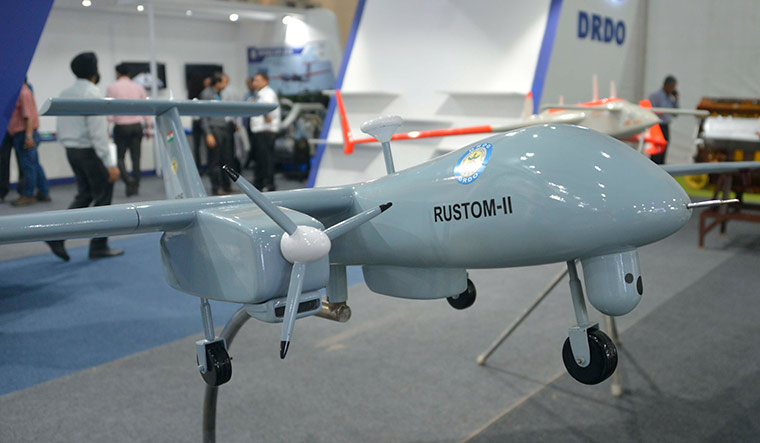The war in Ukraine has once again highlighted the role of drones in combat. Currently, Indian forces are dependent on foreign-made drones, and that too to gather intelligence. But soon, India will have a drone that can be used in armed missions.
Tapas-BH-201, developed by the Bengaluru-based Aeronautical Development Establishment (ADE), recently achieved an altitude of 28,000ft and 18 hours of endurance. The agency, under the DRDO, began developing the medium-altitude long-endurance (MALE) unmanned aerial vehicle a decade ago at a cost of Rs1,540.74 crore; it was later revised to Rs1,786 crore.
“We have a good structural design,” said ADE director Y. Dilip. “This is the first time an India-made drone is going for the certification process. And, very soon, it will be inducted into the armed forces.”
The Centre for Military Airworthiness and Certification (CEMILAC) now has to certify the drone for its airworthiness by checking its load factors, safety and airframe design.
The armed forces had not shown much interest in earlier India-made drones, probably due to delayed timelines; the forces continued to depend on Israel-made UAVs like Heron and Searcher.
Though Tapas is primarily used for surveillance, it can also carry weapons. “It is pre-designed to carry certain weapons and can be converted into an armed platform,” said Dilip.
Tapas has a range of sensors that make it capable of day and night missions, and it also has autonomous take-off and landing capabilities. It is designed only for small missions and can carry a limited payload of 150kg.
The armed forces were especially impressed by the drone’s advanced ground control system. “Now, we have completed the two major requirements of our armed forces—altitude at which the bird can fly and endurance (hours spent in sky),” said S. Rajagopal, project director of Tapas. “When it landed, Tapas still had about eight hours of fuel left. So, we have calculated its endurance up to 18 hours. Despite our best efforts, we are slightly short of the armed forces’ requirements. But a majority of requirements have been met.”
Hindustan Aeronautics Limited will produce the first five Tapas drones. The company is expected to get the drawings for production by May. Between September and April, HAL will do staggered delivery.
The flight control systems, avionics and data-linked systems for the first five Tapas drones are ready. As soon as the airframe is ready, these systems can be fitted quickly. The engines have already been ordered. “We have the planning in place to make a complete aircraft; systems can be equipped quickly,” said Dilip. “We will train the HAL team on the integration of the first two birds. For the remaining birds, HAL will do the integration themselves.” The ADE will only monitor at the production stage.
Bharat Electronics Limited is the primary partner for electronic systems, like on-board avionics. Then, all five Tapas will go in for user evaluation trials. A total of 76 Tapas drones will be inducted into the armed forces—the Army, 60; the Air Force, 12; and the Navy, four.
Though the original completion date of the project was 2016, it was extended to 2023. The government has made it clear that there will be no further extension.
DRDO scientists are also working with a Coimbatore-based private firm on an indigenous engine for Tapas. The drone is currently powered by the Austria-made Austro engine, which comes with twin turbochargers. As of now, close to 75 per cent of the drone is India-made. DRDO scientists claim that, once inducted, Tapas would be almost eight times cheaper than imported drones.


